
Hammeren is the northernmost tip of Bornholm. The granite plateau rises over 50 meters (max. 82 m) above the Baltic Sea. Due to its picturesque location it is one of the most interesting places on the island.
Hammeren - that is how this place was first called on the map in 1539!
The word Hammeren in the Scandinavian countries means "stones" and is often used in the Nordic place names that are found on steep rocks, cliff walls and rocky areas.
On Hammeren, people have lived since the Stone Age. But especially three periods in history have left visible and tangible traces. These are numerous rock carvings around Madsebakke and Hammersholm about the religious world in the younger Bronze Age. Another trace are largest castle ruin in Northern Europe - Hammershus, telling about the medieval battles for power and money. And many large and small craters in the landscape speak about the size and collapse of the quarry industry.

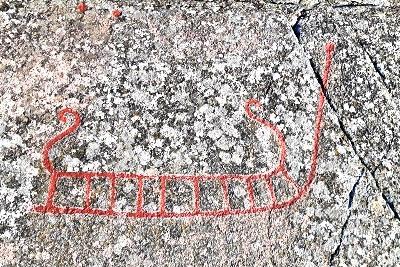
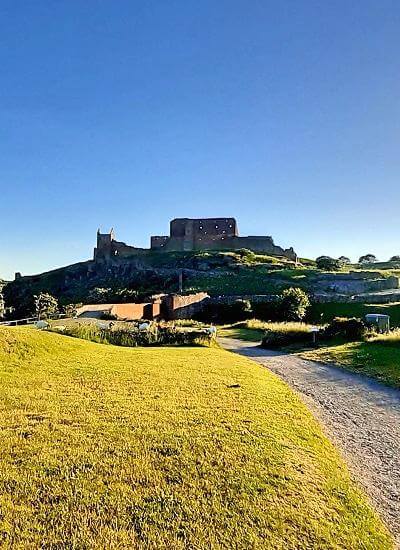

Hammerknuden is a very unique natural area characterized by rock and sea. Here we can see the rock ground in many scenes: from the flat coast of the Hammerodde archipelago to the steep slopes in Hammerhavn and Kongestolen.
Hammerknuden itself is a granite rock rising from the low archipelago up to 82 meters above the Baltic Sea level at the highest point, i.e. around the Hammeren lighthouse on Ørnebjerg, from where there are wonderful views.
Hammerknuden was shaped by glaciers of the last ice age. The ice moved from the northeast and violently "jerked" the rock from this side. Therefore, the north-east coast now seems slightly rounded, gradually rising west. Whereas the west side was sheltered by ice, so only the sea and ordinary weather conditions shaped steep rocks.
The nature of Hammerknuden is characterized primarily by rock: in many places where the layers of soil are thin and the water is almost absent, there are rocky hills. Here, most junipers grow, especially heather, which stains large areas purple, during flowering in late summer.
Hammerknuden also contains several characteristic cultural traces, including the medieval ruins of the Solomon Chapel, two lighthouses and many traces of almost 100 years of granite mining.
Hammerknuden is separated from the rest of Bornholm by a valley of crevices. At the foot of the Crack Valley lies the largest lake on the island - Hammersø.
The Hammer lighthouse on Ørnebjerg is built at the highest point of Hammerknuden - 82 meters above sea level.
The lighthouse captain's building is adjacent to the lighthouse. The lighthouse was built in 1872 from stones excavated several hundred meters away. The nearby Hammerodde lighthouse was erected at the north end of Hammerknuden, and thus at the north end of Bornholm in 1895.
Two lighthouses operated simultaneously for almost 100 years.
Today, the lighthouse belongs to the Bornholm nature agency and entrance is free for visitors.
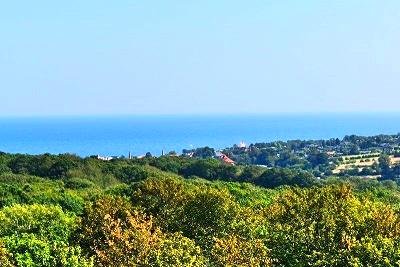



Crystal Lake - is a rainy lake located on a plateau high in the old quarry. The quarry was sometimes called Siberia because it was cold and windy, especially in winter. Siberia is the oldest Hammerknuden quarry.
Mining began in 1872 to extract stones for the construction of the Hammer lighthouse. The plateau offers a fantastic view of Opal Lake, Hammersø, Sandvig and the surrounding area.
Opal Lake is another result of granite mining in Hammeren and shows how large this industry was. In its heyday, the quarry employed several hundred people.
The entire area between the quarry and the port was filled with administrative buildings, forges and steam engines. The port had crushers and 25 hammers that were used to crush larger blocks. A track and later a conveyor were led from the quarry, which led the excavated granite to the bay of Sänen, where in the years 1891–92 a port was built - Hammerhavnen for granite transport.
The Hammer quarry was active from the 1880s to the 1970s, when the quarry was closed as a result of the protection of Hammerknuden in 1968. The Opal Lake is today a swimming pool for the brave with the possibility of jumping down from the edge of the pit down to the lake.
For the braver, this area offers the possibility of various activities: you can climb or slide down the rocks. In summer, a zipline runs from the top of the cliff to the lake. If we want to spend the night in the area or just relax and light a bonfire, we can use two shelters in the area.


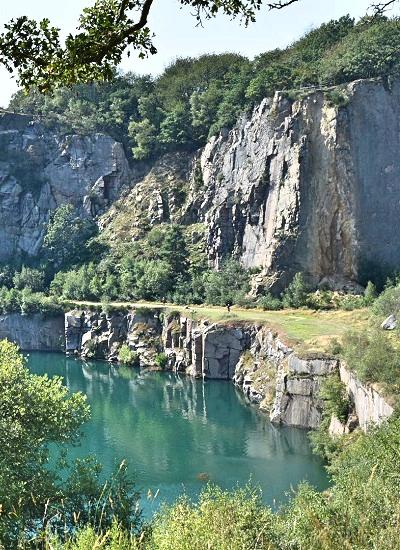
Hammersø is the largest lake in Bornholm. It is only 10 hectares and 13 meters deep.
The surface of the lake is eight meters above sea level. Because it is located right next to Opal Lake, the same attractions are available in the area. However, swimming in Hammersøen is not recommended.
In return, we can fish if we have a valid fishing license. The large and child-friendly fishing pier is suitable for both small and larger anglers.
The port of Hammerhavn in Sænebugt was built in 1891-1892 for granite shipping.
Today, the port is home for leisure boats and yachts. In summer, boat trips for tourists are organized. Along the way, cruise boats also pass Hammershus, Lion's Heads, Camel Heads, Dry Oven and the only bird mountain in Denmark.
Walking paths lead along the cliffs to Wet Oven, a 70-meter-long rock cave. In 2012, three small wooden houses were built in the port.
These include an ice cream kiosk, coffee and sandwiches, a lounge for associations and a service building. In the common building you can see photos from the time of the quarries.
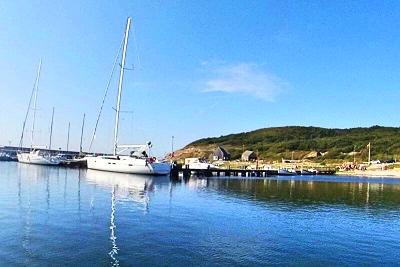



The Chapel of Salomon is a small ruin of the chapel from 1300. The chapel was probably built in connection with the large herring market, which took place in many places on the Baltic coast, including among others here.
On the markets, local fishermen sold herring to merchants from Lübeck. Just below the Salomon Chapel is the natural harbor of Kragkås, which was both a mooring place for fishermen's and traders' boats. Near the ruins inside the dike to the northwest is the ancient holy fountain of Salomon.
The Hammerodde lighthouse was built in 1895 to complement the Hammerfyret lighthouse.
The lighthouse is 12 meters high and the light height is only 21 meters above sea level. Hammerodde lighthouse is still fully functional and belongs to the Danish maritime office. Lights up every night with two flashes every ten seconds.
Hammerodde Lighthouse is the northernmost point of Bornholm.
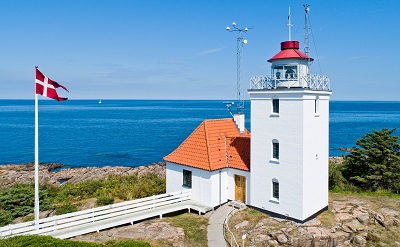
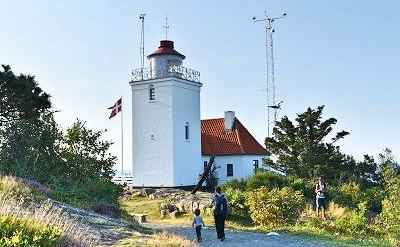

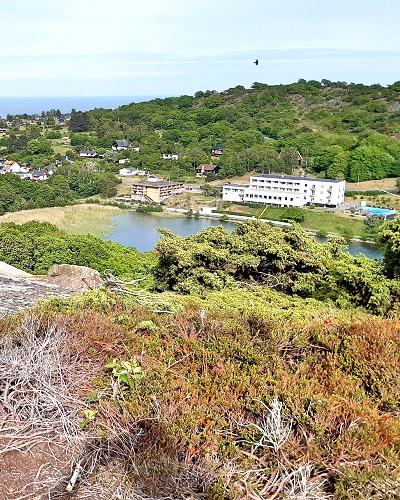
Langebjerg, which is an elongated hill, like Hammerknuden is rounded by ice from the northeast. The small stony lakes between the trees at the top of Langebjerg are old granite quarries. Langebjerg is especially known by children.
Many Danish children are familiar with Langebjerg, because according to the children's book from 1946, the national troll from Bornholm Krølle Bølle used to live on Langebjerg hill. According to legend, Trolls live in Langbjerg and appear every night at midnight.
Langebjerg also offers a great view of the rock carvings from Madsebakken to Hammersholm and towards Hammerknuden and the Opalsø region.
Hammershus the largest medieval castle ruins in Northern Europe were built on an inaccessible rocky hill 70 meters above sea level.
Recent archaeological research by the National Museum proves that Hammershus Castle was built around 1300. It was the church that built the castle, and thus the builder was probably Archbishop Jens Grand of the Danish Lund. From the beginning of the Hammershus construction, it was an important element of the eternal dispute between the church and the royal authority. The castle changed owners many times, but until 1522 it has returned under church rule. Since then, the owners were first German merchants, then representatives of Danish kings and for a short period the castle was in Swedish hands.
Hammershus, in addition to the main castle also had a court building and a prison. In 1743 Hammershus was completely abandoned. Later, the castle fell into ruin and became a place from which everyone could collect building materials. When the castle was protected in 1822, it was already a ruin. Today, the ruins of the castle are regularly maintained, because the walls are constantly destroyed by wind and weather.


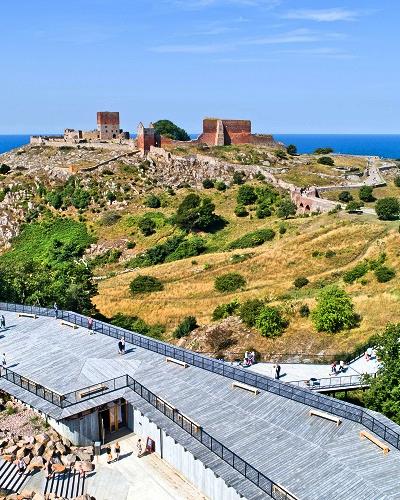

On the slope in Mølledalen opposite the ruins of Hammershus Castle in 2018. the Hammershus Tourist Center was opened.
The Tourist Center has a shop, cafe, toilets and exhibition that tells the story of Hammershus Castle, while in the interactive part of the exhibition you can see the castle model. The visitor center offers a magnificent view of the Hammershus castle ruins, both from the windows of the exhibition and the cafe, but also from the panoramic roof of the building.
An oak bridge leds from the Hammershus Center to the castle ruins. Entrance to the Hammershus Tourist Center and exhibition is free.
The heads of lions and camel are rock-like rock formations at the foot of the steep rock at Hammershus.
The head of the camel lie on a small island and can be seen from the ruins. The lion's heads are slightly north and are best seen from the coast. Both of these rock formations best show their appearance at sunset.

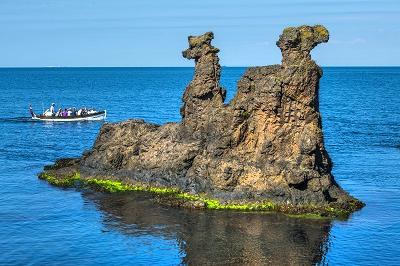

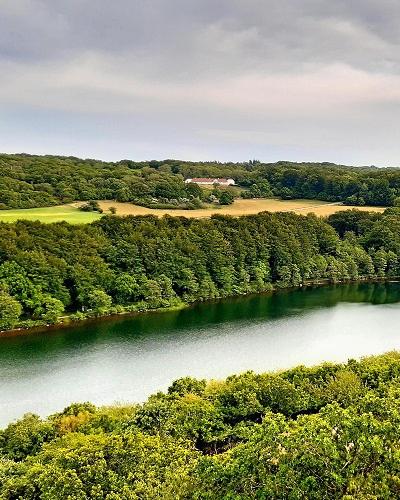
Hammersholm Farm dates back to the late 18th century and is a former breeding farm serving the Hammershus Castle. The farm is currently under protection.
In the area between the Hammersholm farm and Madsebakken there are numerous grave mounds and ancient sites, as well as hundreds of rock carvings. Most of Hammersholm land is used for cattle grazing.
At Hammeren in the region between Hammershus and Allinge-Sandvig we come across a very unique area with rock engravings from the younger Bronze Age (1100-500 BC). Especially the rocky slope Madsebakke on the ridge above Sandvig is known for many rock engravings. This area is the largest in Denmark with fourteen images of ships, five crosses in wheels, five feet of people, and many other drawings carved in the rocks. Hammersholm lies between Madsebakke and Hammershus.
Together with Madsebakke, this area is one of the most important rock engraving areas in Scandinavia. On almost every rock protruding from the ground there are rock carvings. Rock carvings in Madsebakke are regularly maintained and covered with red paint to protect them. Many other engravings are visible only in a specific light or if they are poured with water, then you can feel them with your fingers. It is not known why people from the Bronze Age did such great work by etching their images in hard granite, but these images are probably associated with religious concepts from the Bronze Age.
Archaeological findings indicate that the rock carvings in Madsebakke were a significant place of worship. Along the cliff many traces of fences, hearths and animal bones have been found that may come from ritual meals.
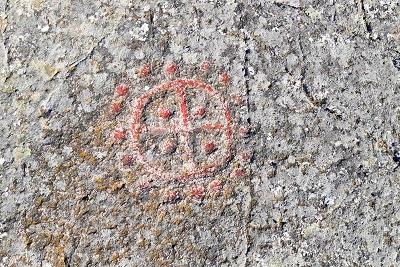



Moseløkken is the only and last active quarry on Hammeren. It was founded in the 1870s by local merchants. Above the quarry is Moseløkkehus, it is the residence of the old chairman of the quarry, which today is a museum.
Outside there is a restored stone crane, as well as two sculptural sheds, in which local sculptors from time to time show visitors how to carve in granite using old tools.
Most of the Slotslyngen reserve area is forested by a diverse and dense forest with small lakes and rocks. In the southern part of the slopes of the castle, towards Vang, we come across rocky hills covered with heather, which bloom purple in late summer.
From here you can see the ruins of Hammershus Castle, and in good weather even Sweden. On the steep rock wall between Slotslyngen and the sea is the only mountain Mulekleven in Denmark. Mussels is the Bornholm’s name for alc, which are sea birds and look like a small penguin. Alks breed on Mulekleven, as do several other species of gulls or rock birds. An ornithological sensation is falcon that returned as a breeding bird to Bornholm in 2004.
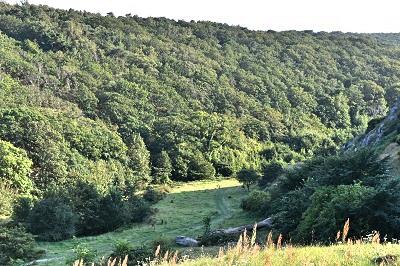


How to get there
By bike: Rønne-Allinge or Slotslyngen-Almindingen cycle route
By bus: Line 2 and 10 Rønne-Hammershus